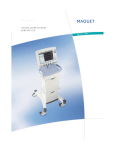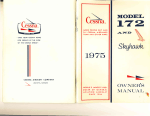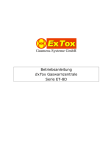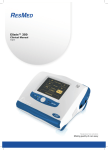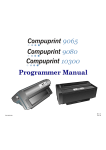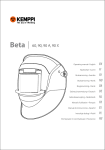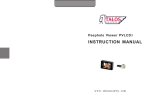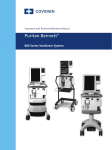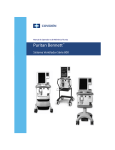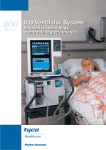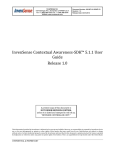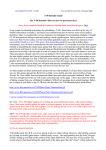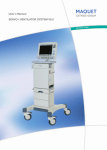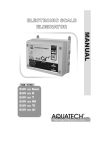Download MV2000 User Manual
Transcript
Copyright ○,C2009 MEKICS Co., Ltd. MEKANT Ventilator User Manual System MEK ICS Co., Ltd. 5F, A-BLDG,WooLimLion, #144-3, Sangdaewon-dong, Jungwon-gu, Seongnam-si, Gyeonggi-do, Korea 462-725 TEL : +82-70-7119-2500 FAX : +82-31-735-2761 URL : http://www.mek-ics.com 0470 All rights reserved Definitions This operator’s manual uses three special indicators to convey information of a specific nature. They include as follow: Warning Indicate a condition that can endanger the patient or the ventilator operator. Caution Indicate a condition that can damage the equipment. NOTE : Indicates points of particular emphasis that make operation of the ventilator more efficient or convenient. MV2000(Touch) Ver 2.0 Section 1 : Introduction .................................................................................... 1-1. Warnings and Cautions 1 ........................................................... 2 1-2. General description ................................................................... 1-2-1. Front picture and the explanation ................................... 1-2-2. Back side picture and explanation .................................. 1-2-3. Left side picture and explanation .................................... 1-2-4. Right side picture and explanation .................................. 5 5 7 9 10 1-3. Specifications ............................................................................. 1-3-1. Features .......................................................................... 1-3-2. Electrical .......................................................................... 1-3-3. Functional Specifications ...................................... .......... 1-3-4. Pneumatic ........................................................................ 1-3-5. Physical data ................................................................... 1-3-6. Environmental data .......................................................... 11 11 11 12 16 16 16 1-4. Standards and safety ................................................................. 1-5. Symbols ..................................................................................... 1-6. Maintenance .............................................................................. 17 18 21 Section 2 : Installation and set up ................................................................... 23 ................................................................................. 23 2-2. External electrical supply ................................................... 2-2-1. AC description ......................................................... 2-2-2. External battery ........................................................ 23 23 25 2-3. Internal battery ................................................................... 2-3-1. Internal battery Indicator .......................................... 2-3-2. How to change internal battery ................................ 26 27 28 2-1. Installation 2-4. Oxygen and Air supply 2-5. Filters .............................................................. 29 ........................................................................................ 30 2-6. Transportation ........................................................................... 2-7. Fuse replacement instruction .................................................... 31 32 MV2000(Touch) Section 3 : Operating instructions Ver 2.0 .................................................................. 35 3-1. Front panel ................................................................................ 3-1-1. Rotational Control Knob .................................................. 3-1-2. Keypad ............................................................................ 3-1-3. LED Indicators ................................................................. 35 35 36 37 3-2. Operating ................................................................................... 3-2-1. Operating procedure and how to use .............................. 37 37 3-3. Display ....................................................................................... 3-3-1. Status information ............................................................ 3-3-2. Waveform and alarm status ............................................. 3-3-3. Menu and setting information .......................................... 3-3-4. TOUCH information ......................................................... 3-3-4-1. VENT TOUCH screen ......................................... 3-3-4-2. Waveform screen ................................................ 3-3-4-3. Menu screen ....................................................... 3-3-4-4. Setting screen ..................................................... 40 41 42 43 44 45 46 47 48 3-4. Start MV2000 ............................................................................. 3-4-1. VENT MODE .................................................................... 3-4-1-1. VACV ................................................................... 3-4-1-2. VSIMV ................................................................. 3-4-1-3. PACV ................................................................... 3-4-1-4. PSIMV ................................................................. 3-4-1-5. SPONT ................................................................ 3-4-1-6. tBiLEVEL ............................................................. 3-4-1-7. NIV ....................................................................... 3-4-1-8. PRVC ................................................................... 3-4-1-9. AUTO ................................................................... 49 50 51 53 56 58 61 63 66 68 71 3-4-2. Monitoring ........................................................................ 3-4-3. Graphics .......................................................................... 3-4-4. Tools ................................................................................ 3-4-5. Events .............................................................................. 72 73 76 77 3-4-6. SYSTEM .......................................................................... 3-4-6-1. SETUP ................................................................. 3-4-6-1-1. BWF ................................................... 3-4-6-1-2. Nebu. Time ......................................... 3-4-6-1-3. O2 SENSOR ...................................... 3-4-6-1-4. Trend Init. ........................................... 3-4-6-1-5. BTPS .................................................. 3-4-6-1-6. Sound Vol. .......................................... 3-4-6-1-7. Altitude ................................................ 3-4-6-1-8. Air Temp. ............................................. 78 78 79 79 79 79 80 80 80 80 MV2000(Touch) Ver 2.0 3-4-6-2. PATIENT ..................................................................... 3-4-6-3. Date ............................................................................ 3-4-6-4. Calibration ................................................................... 3-4-6-4-1. SELF CALIBRATION ................................. 3-4-6-4-2. O2 CALIBRATION ..................................... 3-4-6-4-3. INS-EXP CALIBRATION ........................... 3-4-6-4-4. EtCO2 CALIBRATION ............................... 81 82 83 84 84 84 85 3-4-7. ALARM SET 86 Section 4 : Alarms ................................................................... ............................................................................................ 87 4-1. General Information .................................................................. 4-2. Alarm Massage ......................................................................... 87 88 Appendix ........................................................................................................... A. Operating theory ............................................................................ B. Communications ............................................................................ C. Parts accessories ......................................................................... 90 90 92 95 Service Calls ……………………………………………………..........………………. 97 MV2000(Touch) Ver 2.0 Section 1 Section 1 : Introduction .................................................................................... 1-1. Warnings and Cautions ........................................................... 1-2. General description ................................................................... 1 2 5 1-2-1. Front picture and the explanation ................................... 5 1-2-2. Back side picture and explanation .................................. 7 .................................... 9 .................................. 10 1-2-3. Left side picture and explanation 1-2-4. Right side picture and explanation 1-3. Specifications ............................................................................. 11 1-3-1. Features .......................................................................... 11 1-3-2. Electrical .......................................................................... 11 1-3-3. Functional Specifications 1-3-4. Pneumatic ...................................... .......... 12 ........................................................................ 16 ................................................................... 16 1-3-5. Physical data 1-3-6. Environmental data .......................................................... 16 ................................................................. 17 ..................................................................................... 18 1-4. Standards and safety 1-5. Symbols 1-6. Maintenance .............................................................................. 21 Section 1 : Introduction This operator’s manual explains the way of installation and usage for MEKANT. Notice for use explains general information to be careful while using the product and other notices are written with each function. Users are recommended to be aware of notice for use and all menus before using the product. This operator’s manual is allowed to use by doctors or authorized persons who are permitted to use, or designed to use by qualified and trained persons for using this products. Service, test, correction and main continuous working will be written in service manual of MEKANT Ventilator. However, service manual is allowed to be possesed by authorized persons by MEKICS. 1 Ventilator User’s Manual MV2000(Touch) Ver 2.0 1-1. Warnings and Cautions Warning ━ Please make sure to use MEKANT by authorized persons and read the manual before use. Check the setting figure of various sensors and devices before use. Users shall check out whether the environment is OK before use. ━ Please be aware of the manual provided by the manufacturer when it is used or kept. ━ Do not use it near inflammable anesthetic to avoid any possible explosion. ━ Do not disassemble or open the main body to avoid electrical impulse. Disassembly of the equipment shall be allowed by service staffs approved by MEKICS Co., Ltd. ━ Users shall be careful with circuit joint to be connected with patients. ━ Always shall be careful with leakage of electrical current and consult with hospital technical engineer if any doubt. ━ In case of abnormal working or any damage in the equipment, it shall not be used for patients. ━ Do not touch patient, table or the equipment if a defibrillator is used. ━ Disposable stuffs and disposable circuit for patients shall not be reused. ━ Reusable stuffs used for patients shall be sterilized or washed for reuse. ━ Check out the level before setting alarm. Alarm limitation shall be done for the current selected group. Alarm setting can be changed by level change. ━ Do not correct calibration while used for patient. Please correct it after disconnection from patient if any doubt. ━ Insulate power source in case that the equipment is wet and call a hospital technical engineer. ━ Please connect earth cable to earth connection port to protect patients and the product. ━ Do not disassemble the product in any case. ━ Do not install the various kinds of sensor to patients too strongly and not to be entangled. ━ Do not reuse it if you find this symbol 2 on the accessory, which means disposable stuff. ━ MEKANT shall be tested regularly if it is working in normal condition. ━ Accessories are aseptic products, so the package shall not be torn before use and products shall be free from any defects or cracks. 2 Ventilator User’s Manual MV2000(Touch) Ver 2.0 Caution ━ MEKANT as respiration assistant equipment for adult helps for normal breathing by setting breathing way, breathing volume, breathing times, oxygen density, breathing rate etc in order to solve hypoxia to be appeared from emphysema of the lungs patients or respiratory disease patients. It is respiratory assistant equipment with various alarm function and safety device for safe respiration management, but above all, should be used together with other clinical information for patients’ safety and diagnosis. ━ Avoid the place where there is moisture. ━ Do not handle the equipment with wet hands. ━ Avoid the place under direct rays. ━ Use the equipment within the limits of temperature 10 ~ 40 centigrade and humidity 30 ~ 75% ━ Do not place the equipment near electronic heater. ━ Do not place the equipment under high humidity and bad ventilation. ━ Do not place the equipment where it is possible to take vibration or sudden shock. ━ Do not place the equipment where to be damaged by explosive gas or chemicals. ━ Protect the equipment from dust or metal scrap. ━ Pull out power code with plug grasped, instead of cable. ━ Check out the main equipment and sensor at the same time after cleaning the equipment. Do not use if there is any damage in the equipment. ━ Make the cable and sensor clean after use. Clean them by towel with alcohol soaked and do not use benzene or gasoline. ━ Do not use the equipment in dangerous place. Always be careful with the possibility of bad influence by environment. ━ It is possible to be flew more current than allowed when the assistant device is used. Consult with hospital engineer or authorized local dealer. ━ Check out the basic auxiliary device regularly. Do not use a damaged or electrical unstable device. Consult with hospital engineer if any doubt. ━ Do not use the goods beyond standard certified one. This product shall be used under standard certification. Manufacturer does not take responsibility for the problem occurred while using the product beyond standard certification. ━ The product can be disassembled by educated and authorized staffs. If a user violates this item, after sales service is not provided. 3 Ventilator User’s Manual MV2000(Touch) Ver 2.0 ━ Do not install the various kinds of sensor to patients too strongly and not to be entangled. ━ Do not place the product where it is possible to fall to a patient. ━ Do not move the equipment when power code or high pressure hose cage is connected. It will be harmed for patient or the equipment has an error by itself ━ If a measured figure is turned out not to be correct, consult with hospital engineer or authorized local dealer. ━ Connect the equipment isolated from other devices electronically for patients’ electrical safety. ━ Accessories of MEKANT shall be used with the ones provided by MEKICS or MEKICS’s designated dealer or listed in the manual. MEKICS or MEKICS’s designated dealer provide standard certified products only. ━ MEKANT shall be tested regularly if it is working well. ━ Turn off main switch located backside of the product after use. ━ Place the product in stable position. ━ Use the sensor and cable provided and designated by manufacturer, and consult with hospital engineer or authorized local dealer if you want to use other products. ━ Replace the disposable sensor after use. ━ Sep up the equipment when it is needed. ━ Minimize patient’s move when it is used. ━ Make high pressure hose and cable clean after use. Clean them by towel with alcohol soaked and do not use benzene or gasoline. ━ The Oxygen Air pressure which is impressed pneumatic block should be between 35PSI and 90PSI. Otherwise, it would affect the equipment. ━ Move the equipment with fastened to avoid any possible damage to other products or people by the monitor or cable. ━ Basically, MEKANT is designed not to have functional disorder by surrounded electronic wave. But, it is possible to be occurred any disorder due to high frequency of surrounding. It may be possible to calculate wrong figure, lose present figure or show noisy wave. Please ask MEKICS technical service center or local distributor if you need help. ━ Please turn off the power to recharge the battery when it is not used. ━ MEKANT ventilator system is a product conforming to Class II a. 4 Ventilator User’s Manual MV2000(Touch) Ver 2.0 1-2. General Description MEKANT as respiration assistant equipment for adult helps for normal breathing by setting breathing way, breathing volume, breathing times, oxygen density, breathing rate etc in order to solve hypoxia to be appeared from emphysema of the lungs patients or respiratory disease patients. It is a respiration assistant equipment with various alarm function and safety device for safe respiration management, but above all, should be used together with other clinical information for patients’ safety and diagnosis 1-2-1. Front picture and the explanation ⓑ LCD MONITOR ⓒ KEY FRONT ⓐ CIRCUIT ARM SOCKET ⓐ CIRCUIT ARM SOCKET ⓗ NEBULIZER PORT ⓓ INSPIRATION PORT ⓕ EXPIRATION LEVER ⓖ CARRIAGE GRIP ⓔ EXPIRATION PORT Figure 1-1. Front picture 5 Ventilator User’s Manual MV2000(Touch) Ver 2.0 Part Description ⓐ CIRCUIT ARM SOCKET Install Circuit Arm for patient. ⓑ LCD MONITOR Show the condition of various ventilators and patients. ⓒ KEY FRONT Key button and encoder. ⓓ INSPIRATION PORT Joint hole to connect to patient. ⓔ EXPIRATION PORT Joint hole to connect from patient. ⓕ EXPIRATION LEVER Lock or unlock lever for Expiration Assembly. ⓖ CARRIAGE GRIP Using to move the ventilator. ⓗ NEBULIZER PORT Connection to spray medicines Table 1-1. Front picture description Warning Be careful because heated exhalation assembly due to moisture during exhalation. 6 Ventilator User’s Manual MV2000(Touch) Ver 2.0 1-2-2. Back side picture and the explanation Figure 1-2. Back side picture 7 Ventilator User’s Manual MV2000(Touch) Ver 2.0 Part Description ⓐ SPEAKER For alarm and sound. ⓑ VGA VGA cable connection hole to show patient condition on the other Monitor. ⓑ COMM Cable connection hole to connect PC or central connection. ⓑ TO PNEUMATIC Connection hole to connect to the main body. ⓒAC INLET Connection hole for AC power input. ⓓEXTERNAL BATTERY Connection hole for external battery. ⓔPOWER SWITCH Power on/off switch for common use. ⓕO2 INLET ⓖAir INLET ⓗTANK RELEAF Connection hole to connect to main body using high pressure hose to approve O2 gas. Connection hole to connect to the main body, using high pressure hose to approve air gas. Device to filter the moisture in the Air. Outlet to exhaust the over pressed air when the pressure of air tank is over than 40 PSI. ⓘBATTERY DOOR Door to replace the internal battery. ⓙTO MONITOR Connection for monitor. ⓚCOMM Connection hole for pneumatic communication. Table 1-2. Back side picture description Warning You should be careful with battery’s polarity when it is exchanged. Products can be damaged when polarity is connected wrongly. It should be careful of battery’s terminal to be short on the metal part 8 Ventilator User’s Manual MV2000(Touch) Ver 2.0 1-2-3. Left side picture and the explanation ⓐ LOCKER Figure 1-3. Left side picture Part ⓐ LOCKER Description Locker to disassemble main body with cart. Pull to unlock and push to lock. Table 1-3. Left side picture description 9 Ventilator User’s Manual MV2000(Touch) Ver 2.0 1-2-4. Right side picture and the explanation ⓐ O2 CHANGE DOOR ⓑ INSPIRATION RELIEF Figure 1-4. Right side picture Part Description ⓐ O2 CHANGE DOOR Door to be used for exchanging O2 Sensor. ⓑ INSPIRATION RELIEF Safety valve to exhaust by software, hardware and mechanically when the equipment is out of order. Table 1-4. Right side picture description Warning Do not stop up safety valve to exhaust by software, hardware and mechanically when the equipment is out of order. 10 Ventilator User’s Manual MV2000(Touch) Ver 2.0 1-3. Specifications 1-3-1. Features User friendly POP-up Menu with rotary and push/pull Encoder. 100% O2, Inspiration Pause, Expiration Pause, Key-Lock , Manual and/or Auto Nebulizer Dual Alarm ( Speaker / Buzzer ) system External battery ( for Mobile application ) 1-3-2. Electrical Specifications 100 - 120 VAC, 10A 50/60 Hz 200 - 240 VAC, 5A 50/60 Hz AC input voltage AC input FUSE Rating 250V/6.3A Power consumption 84 W max External DC input voltage 12V @ 7A Pb battery Internal battery Battery ; 12V / 7A Pb battery Operating time: 3 hours minimum . Recharge time; 4 Hours max. Please change it after 2 years use. It can be used for 30 minutes normally. On the other hand, it will be more than 30 minutes if power consumption is small. Communication Central interface ; RS-232 serial interface Baud rate 115,200bps, Upgrade (Main board, Pneumatic board) Display 12.1” LCD monitor, 800*600, 11 Ventilator User’s Manual MV2000(Touch) Ver 2.0 1-3-3. Functional Specifications MODE V-ACV Volume Assist Controlled Ventilation Controlling patient’s mechanical artificial respiration based on air volume and adjusting inspiration and exhalation time by force. V-SIMV Volume based Synchronized Intermittent Mandatory Ventilation Controlling artificial respiration based on air volume in accordance with patient’s voluntary respiration. SPONT Spontaneous Ventilation Give pressure support centering on voluntary respiration. P-ACV Pressure based Assistance Controlled Ventilation Controlling patient’s mechanical artificial respiration based on pressure. P-SIMV Pressure based Synchronized Intermittent Mandatory Ventilation Controlling artificial respiration based on pressure in accordance with patient’s voluntary respiration. tBiLEVEL Same as SPONT and exist Upper PEEP (Refer to SPONT mode) NIV Non Invasive Ventilation During artificial respiration by mask type, not tubing type, P-ACV working in allowance of air leakage. (Refer to P-ACV mode) PRVC Pressure Regulated Volume Controlled Ventilation Breaths are delivered mandatorily with a constant flow to assure present volumes. AUTO Start quickly according to body weight. (Working in P-ACV mode) 12 Ventilator User’s Manual MV2000(Touch) Ver 2.0 SETTING PARAMETER Setting range BW 3 kg ~ 150 kg Pressure 5 ~ 80 cmH2O Condition Default 10ml/kg ±(1.7 + 4% of the actual 30 cmH2O reading) cmH2O Plateau Time (pause) 0 ~ 2 sec PEEP 0 ~ 45 cmH2O 0.1 sec ±(1.7 + 4% of the actual 3 cmH2O reading) cmH2O High PEEP 5 ~ 45 cmH2O ±(1.7 + 4% of the actual +15 cmH2O reading) cmH2O Low PEEP 0 ~ 45 cmH2O ±(1.7 + 4% of the actual +3 cmH2O reading) cmH2O High PEEP time 0.2 ~ 24 sec Low PEEP time Infinite 1 sec ±10 % Setting range Condition Default Inspiration time 0.2 ~ 9.9 sec ±10 % 1 sec Fend 25 ~ 100 % TRISE 0.1 ~ 0.5 EnSENSE % 10 ~ 60 % 30 % ExSENSE % 10 ~ 60 % 30 % Pressure Support 0 ~ 45 cmH2O 100 % 0.1sec ± 0.05 ±(1.7 + 4% of the actual 0 cmH2O reading) cmH2O Trigger sensitivity 0.5 ~ 20 cmH2O ±(1.7 + 4% of the actual Pressure Trigger reading) cmH2O sensitivity 0.5 ~ 20 L/min 5 lpm ±15 % (VMIN>3lpm) ±0.5lpm (VIMIN≤3lpm Flow Volume 5 cmH2O 5 ml ~ 2500 ml ±15 % (VTIDAL>100ml) 10 ml/kg ±20ml (VTIDAL≤100ml) Rate 2 ~ 120 bpm ±2 bpm 20 bpm O2 % 21 ~ 100 % ±3 % 30 % 13 Ventilator User’s Manual MV2000(Touch) Nebulizer Ver 2.0 Setting range Default 10 ~ 180 min off Limited 200ml Flow trigger base flow cannot use Inspiration pause Resistance measurement off Expiration pause Compliance measurement off Manual Inspiration Setting tidal volume off 100% O2 3 minutes off AUTO MODE(Emergency Start Ventilation) Setting range I:E 1:2 O2 60 % Mode PACV Inspiration Pressure 25 cmH2O Inspiration time 1 sec Expiration time 2 sec Respiration rate 20 bpm PEEP 3 cmH2O Trigger type Pressure Trigger sensitivity 3 cmH2O Rise % 50 % Alarm limit Auto set E-sense 30 % 14 Ventilator User’s Manual MV2000(Touch) Ver 2.0 Alarms Setting range PRESSURE HIGH 5 cmH2O ~ 120 cmH2O PRESSURE LOW 0 cmH2O ~ 50 cmH2O VTIDAL HIGH 5 ml ~ 2500 ml ,OFF VTIDAL LOW 0 ml ~ 2500 ml PEEP HIGH 6 cmH2O ~ 45 cmH2O PEEP LOW 0 cmH2O ~ 7 cmH2O O2 HIGH 1% ~ 100%, OFF O2 LOW 0% ~ 100% R-R HIGH 3 ~ 150 BPM R-R LOW 2 ~ 149 BPM VMIN HIGH 0.1 ~ 50 LPM VMIN LOW 0 ~ 49.9 LPM AIR FAIL - O2 FAIL 0 ml ~ 500 ml AIR LEAK AIR OBST OFF, 10 ~ 60 sec APNEA VENT INOP - O2 SENSOR ERR - CIRCUIT OPEN - BATTERY MODE - LOW BATTERY DC power loss COM ERROR 15 Ventilator User’s Manual MV2000(Touch) Ver 2.0 1-3-4. Pneumatic Specifications 35 ~ 90 psi O2 and air supply Pressure range Flow 150 L/min (STPD, dry required) 100 % O2 Suction button– auto calibration Oxygen sensor life 10,000 hours or 1 Years of use, normal Safety pressure Pneumatic 30 psi +/- 10 % Internal pressure Limit 85 cmH2O +/- 10% ; Inspiration Pressure Limit Mechanical release valve Double safety mechanism for over pressure 1-3-5. Physical Data Dimensions of device 38 W x 43 D x 69 H cm (Width x depth x height of device) Weight of device 35 Kg (with Battery) Dimensions of Cart 49 W x 56 D x 77 H cm (Width x depth x height of device) Weight of Cart 28 kg Connectors Inspiratory limb connector ISO 22mm conical male Expiratory limb connector ISO 22mm conical male Air and Oxygen inlets DISS male / female 16 Ventilator User’s Manual MV2000(Touch) Ver 2.0 1-3-6. Environmental Data Operating environment Temperature : 10 to 40 °C (50 ~ 104℉) Atmosphere 700 to 1060 mbar (10.2 ~ 15.4 psi) Altitude -443 ~ 3280 m (-1350 ~ 10,000 ft) Storage environment Temperature -10 to 60 °C Relative humidity 10 to 85 % Atmosphere 500 to 1060 mbar (7.3 ~ 15.4 psi) Altitude up to 6560 m (20,000 ft ) Oxygen/Air inlet supply pressure 35 ~ 90 psi 1-4. Standard and Safety requirements MEKANT is in conformity with the following tables. Obtainment of license and required testing has been completed. EN60601-1:1990 General requirements for Safety EN60601-1-1:2001 Electromechanical Safety EN60601-1-2:2001 Electromagnetic Compatibility Requirement and tests IEC 60601-2-12:2001 Particular requirements for the safety of lung ventilators for medical use 17 Ventilator User’s Manual MV2000(Touch) Ver 2.0 1-5. Symbols and Labels Descriptions for marking on MEKANT ventilator and its operational manuals. No Name Symbol Explanation Provision of power by switching on and off the 1 POWER ON/OFF system. IEC 601-1 It is indicated terminal which do not need ground electric potential to make equipotential by 2 Equipotential-ity connecting with each part of system or equipment. IEC601-1, IEC 417-5021 Attention, 3 Indicates the necessity to refer to the operational Consult manual prior to equipment operation. accompanying IEC 601-1 documents 4 5 Indicates the stand-by mode of the system. stand-by IEC417-5009 Start Indicate the activation of the equipment. IEC 417-5104 (of action) Indicates appropriateness for the equipment 6 against Direct current direct current and designate the connecting part. IEC 601-1, IEC 417-5031 Battery capacity indicator 7 FULL Charging 80% Charging 50% Charging 20% Charging Battery check Low Charging 18 Ventilator User’s Manual MV2000(Touch) No Name 8 AC Power plug Ver 2.0 Symbol Explanation Indicates the AC plug without ground earth. IEC 417-5534Pr It 9 Battery + - 10 EXT. BATT 11 Manual control 12 CLEAR 13 14 EXT. BATT be indicated rating sticker that equipment is suitable for only direct current (D.C). Also, indicate it is related connecting part. IEC 601-1, IEC 417-5031 Indicates external battery for vehicle use. Indicates manual operation of the apparatus. ISO7000-0096 Clears the menu tree from the display. Dangerous Warns the high voltage. IEC601-1, IEC417-5036, ISO 3864 voltage 100% O2 MODE should O2 100% Indicate 100% O2 MODE. This mode can by ON / OFF by O2 100% KEY Indicate NEBULIZER MODE. 15 NEBULIZER This mode can be ON / OFF by NEBULIZER MODE KEY, and the operating time is set from 10 to 180 minutes. MANUAL 16 INSPIRATION KEY Supply the respiration to the patient when pressing the MANUAL INSPIRATION KEY. 19 Ventilator User’s Manual MV2000(Touch) No 17 18 19 Name Ver 2.0 Symbol Explanation INSPIRATION Increase INSPIRATION TIME to 1 second. HOLD EXPIRATION Increase EXPIRATION TIME to 2 second. HOLD Indicate ALARM SOUND OFF or MUTE. ALARM SOUND This function can be ON / OFF by pressing 2 OFF Or MUTE MIN KEY. Table 1-5. Description of Symbols 20 Ventilator User’s Manual MV2000(Touch) Ver 2.0 1-6. Maintenance The following table shows the periodic check point and maintenance method for MEKANT ventilator system and the circuit system. Period Subject Check point Bacteria Filters - Inspiratory Filter Check if all filters are in good position. - Expiratory Filter Daily Patient Circuit System Check if there is moisture and Water Traps remove it if necessary. Patient Circuit System, all month or when Bacteria Filters and changed the patient Humidification Chamber Every Half year All system All Bacteria Filters autoclaving Between 1 year and 2 year Exchange everything, and cleaning and sterilizing used one. Conduct EST After 100 times Blockage and moisture. Collector Vial, Gas Supply Minimum Every half Every year or Check the connection, leakage, Oxygen Sensor Exchange to new filter and scrap used one Exchange to new one Conduct Oxygen sensor calibration When necessary Oxygen Sensor Every 10,000 hours Various components by pressing 100% O2/CAL. Exchange appropriate components using 10,000 hours PM kit. Table 1-6. Check and Maintenance Period 21 Ventilator User’s Manual MV2000(Touch) Ver 2.0 Caution User should check the installation status and problem of the filters and patient circuit system with naked eyes every day. In case of any problem, replace or exchange the parts in problem right away. When patient is changed or one patient uses it for a long period, exchange the patient circuit system including bacteria filter in every 15 days, and clean and sterilize the used one. All the components of patient circuit system excluding bacteria filter can be sterilized by any way among ETO(Ethylene Oxide) gas sterilization, Steam Autoclave and Chemical sterilization. But, only Steam Autoclave is available for bacteria filter. Sterilization shall be done for about 20 minutes at 132 degree centigrade. Exchange to new bacteria filter after one year use or 100 times of Autoclave use. Oxygen sensor is valid for 2 years, but it can be shortened in case of using at the condition of high FiO2 or high temperature. 22 Ventilator User’s Manual MV2000(Touch) Ver 2.0 Section 2 Section 2 : Installation and set up 2-1. Installation ................................................................... 23 ................................................................................. 23 2-2. External electrical supply ................................................... 23 ......................................................... 23 ........................................................ 25 ................................................................... 26 2-2-1. AC description 2-2-2. External battery 2-3. Internal battery 2-3-1. Internal battery Indicator 2-3-2. How to change internal battery ................................ 28 .............................................................. 29 ........................................................................................ 30 2-4. Oxygen and Air supply 2-5. Filters 27 .......................................... 2-6. Transportation ........................................................................... 2-7. Fuse replacement instruction .................................................... Section 2 : INSTALLATION AND SET UP 2-1. Installation When installing and moving the equipment, it is required to stay shock free. 2-2. External electrical supply MEKANT is capable to receive both AC and DC power supply. 2-2-1. AC description External AC connector is located on the rear side of the apparatus. Refer to Figure 2-1. Figure 2-1. External AC and DC Power Supply Sockets 23 Ventilator User’s Manual 31 32 MV2000(Touch) Ver 2.0 Warning Prior to applying AC or DC to the ventilator, the line frequency has to be adjusted to the local standard otherwise it might cause damages to the apparatus. Power Cord has to be plugged in to the concentric plug on the ground. Replace covered wire in case of wear and tear. Please apply the ground cable in order to protect the patient and the apparatus. Maintain the same level of input & output voltage. Caution Cable Clips are used in order to affix the AC code and also to prevent disconnection. When connected to DC or AC, LED display will be turned on to indicate the connection. 24 Ventilator User’s Manual MV2000(Touch) Ver 2.0 2-2-2. External battery ① ④ ③ ② Pin Name Direction Explanation ① Not connected Not used ② GND Pins for the ground. ③ +VCC Pins to connect external battery ④ Not connected Not used Table 2-2. Pin Setting of MV2000 Ventilator External Battery Warning Watch for polarity when connecting the battery. Note that when external battery is used, internal battery will not be charged. It should be used for rating voltage, 12V 7A and Electric current should be more than 7A. Caution Cover the Port Pin by putting the cap when the external battery is not in use. Do not make pin to be shorted because internal Battery is damaged when EXT. BATT is opened, or each pin is shorted. Please put a cap next to terminal when EXT. BATT is not used. NOTE : Fuse is built in the machine. ATO® Fuse (Fast-Acting Type), Catalog Number 257 015, Ampere Rating (A) 5A, Body color code : blue Vehicle outlet power supply is used. 25 Ventilator User’s Manual MV2000(Touch) Ver 2.0 2-3. Internal battery Internal battery for MV2000 is used for the provision of power when moving the patients. Recharge of the battery is done while AC power connected as the apparatus simultaneously utilizes the power from the same source of AC. In case of power failure, the operation will be done by internal battery. Warning When replacing the battery, watch for polarity. Red for +, Black for -. Inappropriate connection might cause damages to the apparatus. Short-circuit might cause explosion of the battery or harm human body due to high voltage. It should be used for rating voltage, 12V 7A and Electric current should be more than 7A. We recommend that you should contact the distributor or CS team if you find any problems in the internal battery. Caution When difficulties of power supply arise or when transferring the patients, the battery needs to be charged. Replace the battery if it is in deficiency. In case of the lowest battery voltage, there may be an error in the measured value. In case of low battery, use the machine after connection to AC common electric power. NOTE : Fuse is built in the machine. ATO® Fuse (Fast-Acting Type), Catalog Number 257 015, Ampere Rating (A) 5A, Body color code : blue Internal Battery may be affected by the number of times for discharge, surrounding temperature, charging voltage. Generally it can be used more than 2 years. 26 Ventilator User’s Manual MV2000(Touch) Ver 2.0 2-3-1. Internal battery indicator It displays battery capability. This is displayed on the upper right hand corner of the LCD display. The battery capacity will be displayed in 5 main statuses. Battery Indicator Level Status Explanation Full Charging 80% Charging 50% Charging 20% Charging In case of discharging status, the system will Low Charging be automatically turn off to protect the battery 5 minutes later. Table 2-3-1. Internal battery Indicator 27 Ventilator User’s Manual MV2000(Touch) Ver 2.0 2-3-2. How to change internal battery No. Figure Explanation Unscrew 4 screws on the lower rear ⓐ cover that is for Battery You can see the internal battery. After ⓑ changing battery, assemble the battery cover. Table 2-3-2. How to change internal battery Warning When replacing the battery, watch for polarity. Red for +. Black for -. Inappropriate connection might cause damages to the apparatus. Short-circuit might cause explosion of the battery or harm human body due to high voltage. Caution All of bolt is locked when turned clockwise. All of bolt is loosed when turned counter clockwise. 28 Ventilator User’s Manual MV2000(Touch) Ver 2.0 2-4. Oxygen and Air supply MEKANT is the system to provide oxygen and air to patients. Oxygen and Air are provided through the adaptor end at the rear by pressure (35 ~ 90 PSI) and get mixed to have appropriate concentration. No. Figure Explanation 1. O2 consists of green adaptor and green high pressure hose. ⓐ 2. Air input consists of a yellow color. Table 2-4. Connection way of high pressure hose Warning Check the oxygen and air connector to be free from oil to prevent from explosion. When you supply or stop oxygen and air, be careful when it’s assembled and disassembled because high pressure hose can harm to human body due to inside pressure. Caution Check and see if the Oxygen and Air pressure is set at exact pressure range prior to ventilator application. When high pressure hose is used or moved, pay attention to wiring not to be tripped over persons. 29 Ventilator User’s Manual MV2000(Touch) Ver 2.0 2-5. Filters Use 2 filters between MEKANT Product and patient for the safety of patients. Before supplying for patient INS. Filter is used, and exhalation filter is used at the place for exhaled air from patient’s body in order not to supply polluted air to patient. Warning Contaminated gas might be in exposure to patients if the air was provided without applying filter. Do not reuse the accessories when symbol is found since it represents its category as disposable. Replace the disposable sensor with the new one after single use. Reusable materials which are used for patients shall be sterilized and washed for reuse. Caution Filters must be MEKICS genuine or designated products. If you wish to use other makes, please consult biomedical engineers at the hospitals, or local authorized dealer. Please use quality certified product, otherwise manufacturer will not be responsible for any problems caused by this. All accessories are aseptic; therefore the wrapping has to be intact before opening and use. 30 Ventilator User’s Manual MV2000(Touch) Ver 2.0 2-6. Transportation No. Figure Explanation 1. Move the product by handle. ⓐ Table 2-6. Handle of the Cart Warning When moving the apparatus, please make sure that the LCD Monitor is fixed properly since this might cause damage to the Device. Please move the product when components and power cords are in order. Caution Before moving the system, unlock the locker on the caster. 31 Ventilator User’s Manual MV2000(Touch) Ver 2.0 2-7. Fuse replacement instruction ⓐ INLET FUSE Figure 2-5. AC INLET FUSE No. Name Figure Explanation 1. Pull the upper part of inlet toward you. 2. Fuses are located where two upper arrows are and those are and those lower ⓐ 2 arrows indicate the direction when inserted. INLET FUSE 3. Remove the existing fuse and insert the new fuse as shown in the picture after checking the rating. 4. Close the inlet by doing the steps backward. Table 2-3. How to change fuse 32 Ventilator User’s Manual MV2000(Touch) Ver 2.0 Section 3 Section 3 : Operating instructions 3-1. Front panel .................................................................. 35 ................................................................................ 35 3-1-1. Rotational Control Knob 3-1-2. Keypad .................................................. 35 ............................................................................ 36 3-1-3. LED Indicators 3-2. Operating ................................................................. 37 ................................................................................... 37 3-2-1. Operating procedure and how to use 3-3. Display .............................. 37 ....................................................................................... 40 3-3-1. Status information ............................................................ 3-3-2. Waveform and alarm status ............................................. 42 .......................................... 43 ......................................................... 44 3-3-3. Menu and setting information 3-3-4. TOUCH information 3-3-4-1. VENT TOUCH screen ......................................... 45 ................................................ 46 ....................................................... 47 ..................................................... 48 ............................................................................. 49 3-3-4-2. Waveform screen 3-3-4-3. Menu screen 3-3-4-4. Setting screen 3-4. Start MV2000 41 3-4-1. VENT MODE .................................................................... 50 3-4-1-1. VACV ................................................................... 51 3-4-1-2. VSIMV ................................................................. 53 3-4-1-3. PACV ................................................................... 56 3-4-1-4. PSIMV ................................................................. 58 3-4-1-5. SPONT ................................................................ 61 ............................................................. 63 ....................................................................... 66 3-4-1-8. PRVC ................................................................... 68 3-4-1-9. AUTO ................................................................... 71 ........................................................................ 72 .......................................................................... 73 ................................................................................ 76 .............................................................................. 77 3-4-1-6. tBILEVEL 3-4-1-7. NIV 3-4-2. Monitoring 3-4-3. Graphics 3-4-4. Tools 3-4-5. Events 33 Ventilator User’s Manual MV2000(Touch) Ver 2.0 3-4-6. SYSTEM .......................................................................... 3-4-6-1. SETUP ................................................................. 3-4-6-1-1. BWF ................................................... 3-4-6-1-2. Nebu. Time ...................................... 79 ........................................... 79 .................................................. 80 3-4-6-1-6. Sound Vol. 3-4-6-1-7. Altitude .......................................... 80 ................................................ 80 ............................................. 80 3-4-6-1-8. Air Temp. 3-4-6-3. Date 79 79 3-4-6-1-4. Trend Init. 3-4-6-2. PATIENT 78 ......................................... 3-4-6-1-3. O2 SENSOR 3-4-6-1-5. BTPS 78 ..................................................................... 81 ............................................................................ 82 3-4-6-4. Calibration ................................................................... 3-4-6-4-1. SELF CALIBRATION 3-4-6-4-2. O2 CALIBRATION ................................. 84 ..................................... 84 3-4-6-4-3. INS-EXP CALIBRATION 3-4-6-4-4. EtCO2 CALIBRATION 3-4-7. ALARM SET ........................... 84 ............................... 85 ................................................................... 34 83 Ventilator User’s Manual 86 MV2000(Touch) Ver 2.0 Section 3 : Operating instructions 3-1. Front panel 3-1-1. Rotational control knob Rotating and Pressing the Encoder allows a user to navigate through and make changes to the display element. Right Rotating Left Rotating - Menu Down - Menu Up - Left Value - Right Value Click - Menu confirmation & storing Figure 3-1. Encoder 35 Ventilator User’s Manual MV2000(Touch) Ver 2.0 3-1-2 Keypad Figure 3-1-2. Keypad Part Number Picture Description Start Switch, Standby 1) If you press START switch for 0.5 sec, power would be on. In case of STOP OFF you want, switch should be pressed for longer than 10 seconds in Vent ⓐ operating. 2) Switch should be pressed for longer than 5 seconds in Vent Ready status. 3) In case of STANDBY you want, switch should be pressed in Vent operating. ⓑ ⓒ ⓓ MANUAL INSPIRATION 100% O2 MANUAL INSPIRATION: This function which is for a respiration according to Ventilator's default is operated once by pressing the key. 100% O2 : If you press this button, 100% O2 is provided for 3 minutes. CLEAR : It is used for clearance of menu when menu is controlled by Knob 36 Ventilator User’s Manual MV2000(Touch) Part Number Ver 2.0 Picture Description ACCEPT RUN : It is used when Ventilator is working ⓔ ACCEPT as its final value. If ACCEPT key is not pressed, setting value would not be accepted on the change of MODE and VENT SETTING. This is for the safe. ⓕ 2MIN ALARM 2 MIN : This makes ALARM remove for 2 minutes. ALARM RESET : This actives when alarm is reset. ⓖ RESET And previous alarm lamp is removed and the status of NORMAL will be. Encoder : Rotary switch for selecting function on the ⓙ pop-up menu. Table 3-1-2. Keypad 3-1-3. LED Indicators Part Number Picture Description AC POWER ON LED : LED is on when machine is ⓗ connected to AC, otherwise, LED is OFF. BATTERY ON LED : Battery is charged as the machine is working when it is connected AC ⓘ If it is not, battery ON LED is lighted because the machine is operating by — ┼ internal battery. If both AC POWER ON LED and BATTERY ON LED are OFF, battery should be charged. Table 3-1-3. LED Indicators 37 Ventilator User’s Manual MV2000(Touch) Ver 2.0 3-2. Operating Caution Buzzer will be sounded when main power is on normally. Otherwise, check something wrong on the main power. (power, battery, fuse) ALARM LAMP (Warning or INOP) is on and buzzer is sounded if ventilator has defect on working . Connect the ventilator to the power is earthed. 3-2-1. Operating procedure and how to use No. 1 Picture Description 1) Connect high pressure hose and accessories. 1) Connect earthed cable to equipotential port and earthed AC power. 2 2) Connect power cord to an electric outlet and AC inlet. 3) Switch on POWER on the back side. 38 Ventilator User’s Manual MV2000(Touch) Ver 2.0 1) Switch on START on the Front Panel. System Fail sound will be disappeared in case power is on normally. 3 2) Wait for the calibration of each sensor. It is presented normal INITIAL, and then normal ventilator READY is appeared. 1) Set the present time and date.. (In an emergency, can be omitted.) 2) Enter patient’s bed number etc. (In an emergency, can be omitted.) 3) In Standby Screen, Select patient's ages and input patient's height. Press START button. 4 4) In top right corner, press Modes button and Choose mode suitable for the patient. Input other value as prescription. Adjust value by pressing and rotating. 5) Select ACCEPT button. 6) Adjust alarms properly. 7) Check the wave form and figure on the monitor normally. Figure 3-2-1. Operating procedure and how to use 39 Ventilator User’s Manual MV2000(Touch) Ver 2.0 3-3. Display Refer to 3-3-1 Refer to 3-3-2 Refer to 3-3-3 Figure 3-3. LCD Display Explanation Reference Measurement information Measurement of ventilator or patient factor. 3-3-1 Waveform and alarm status Graph and alarm statue of ventilator or patient factor. 3-3-2 Menu and Setting information Menu button and Setting value according to respiratory mode. 3-3-3 Table 3-3. Description of display explanation 40 Ventilator User’s Manual MV2000(Touch) Ver 2.0 3-3-1. Status and measurement information It displays measurement information of ventilator or patient factor. It shows different tables of measurement information to each Mode. By default, VE TIDAL, VE MIN, RRESP, PPEAK and PMEAN be displayed. Press buttons in bottom left of the screen. It can be change different values. Measurement items are displayed by the page as follows. Page number Displayed items 1 PPEAK, PPAUSE, PMEAN 2 PEEP, AutoPEEP, P 0.1 3 VI TIDAL, VE TIDAL, VE MIN 4 PEEPH, PEEPL, FPEAK 5 RRESP, RRSPONT, VEMIN SPONT 6 TI , T E, I : E 7 EXP.FLOW, RSBi, O2 8 CL, RA 9 HR, SpO2 10 EtCO2, Ins, RRESP Table 3-3-1. Displayed items by the page Displayed status can be confirmed in Monitoring Menu overall. If you want more information, refer to [3-4-2. Monitoring]. 41 Ventilator User’s Manual MV2000(Touch) Ver 2.0 3-3-2. Waveform and alarm status It displays WAVE, ALARM STATUS and MESSAGE to ventilator or patient factor. Refer to Section 4 for alarm information. ⓐ Alarm message ⓑ Freeze Button ⓒ WAVE Figure 3-3-2. Waveform, Freeze and Alarm status Part Number Display Explanation ⓐ Alarm message It displays alarm message. Refer to Section 4 for alarm information. ⓑ Freeze button If press Freeze button, measurement keep going but display stop. Press Freeze button again, display start again. ⓒ WAVE It displays waveforms of Pressure, Flow, Volume, SpO2(Option), EtCO2(Option), P-V. V-F, P-F graph and Trend graph. Refer to [3-4-3. Graphics] for alarm information. Table 3-3-2. Waveform and alarm status explanation 42 Ventilator User’s Manual MV2000(Touch) Ver 2.0 3-3-3. Menu and Setting information It displays respiratory mode of VENT Mode. It shows different table of setting table to each Mode. ⓒ ⓓ ⓐ ⓑ Figure 3-3-3. Menu and Setting information Display explanation Part Number Display ⓐ Menu ⓑ Setting information ⓔ Explanation Refer to [3-3-4-3. Menu Screen] Refer to [3-3-4-4. SETTING TOUCH] It displays AC Power. (It maybe changed Battery ⓒ Status) ⓓ TOUCH ON/OFF ⓔ It displays ratio of I:E Table 3-3-3. Setting information Display explanation 43 Ventilator User’s Manual MV2000(Touch) Ver 2.0 3-3-4. TOUCH SCREEN MV2000(Touch) can be operated by screen touch. It displays the Touch Area on screen. It is possible to touch the area within outlined area. ⓐ ⓑ ⓒ ⓓ ⓔ Figure 3-3-4. TOUCH Screen information Part Number Display ⓐ VENT TOUCH ⓑ Waveform ⓒ Status information ⓓ Menu ⓔ Setting screen Explanation Ref. 3-3-4-1 Select to change the vent mode. If you TOUCH waveform screen, the waveform can be converted to other waveforms. Can be change different values. Refer to [3-3-1. Status information] 3-3-4-2 - Select to change the menu setting with touch. 3-3-4-3 During vent mode operating, you can change the vent setting value. 3-3-4-4 Table 3-3-4. TOUCH Screen information explanation 44 Ventilator User’s Manual MV2000(Touch) Ver 2.0 3-3-4-1. VENT TOUCH SCREEN You can go directly to the breathing mode settings in [VENT] TOUCH area Figure 3-3-4-1(1). VENT MODE SETTING SCREEN If you choose VENT MODE, the following screen will appear. After entering the setting, touch [ACCEPT] button, chosen mode will start. Refer to [3-4. MV2000 Start] Figure 3-3-4-1(2). VENT MODE setting screen (V-ACV Mode) 45 Ventilator User’s Manual MV2000(Touch) Ver 2.0 3-3-4-2. Waveform screen The border area is the waveform screen Figure 3-3-4-2. Waveform screen information If you TOUCH waveform screen, you can be change the measured graph. Refer to [3-4-3. Graphics] 46 Ventilator User’s Manual MV2000(Touch) Ver 2.0 3-3-4-3. MENU SCREEN As follow; TOUCH Menu screen or use encoder, for each menu screen appears. Figure 3-3-4-3. MENU SCREEN information For a description of each menu are as follows. Part Explanation Number Ref. Overall, the measured data shows for each mode. 3-4-2 Can set Screen Layout and Trend Timing. 3-4-3 Use Insp. hold and Exp. hold. 3-4-4 Events Can check Event occurred. 3-4-5 System Setup preferences, patient information, date modified, calibration settings are configured. 3-4-6 Alarms Set the alarms. 3-4-7 Monitoring Graphics Tools Table 3-3-4-3. MENU SCREEN explanation 47 Ventilator User’s Manual MV2000(Touch) Ver 2.0 3-3-4-4. SETTING screen In breathing mode of operation, you can select the area of the SETTING screen (figure 3-3-4-3) and change the vent variable. If you re-click that variable, change the breathing variable that is applied immediately. Figure 3-3-4-3. SETTING TOUCH screen information (V-ACV mode) Also, depending on the operating mode automatically changes SETTING screens. VENT MODE SETTING screen list V-ACV V Tidal, R RESP, T PAUSE, F PEAK, PEEP, O2 V-SIMV V Tidal, R RESP, T PAUSE, F PEAK, PEEP, O2 P-ACV P INSP, R RESP, T INSP, T RISE, PEEP, O2 P-SIMV P INSP, R RESP, T INSP, T RISE, PEEP, O2 SPONT P SUPP, T RISE, APNEA, T RIG, PEEP, O2 tBiLEVEL P SUPP, R RESP, TH PEEP, PEEP H, PEEP L, O2 NIV P INSP, R RESP, T INSP, T RIG, PEEP, O2 PRVC V Tidal, R RESP, T INSP, T RIG, PEEP, O2 AUTO P INSP, R RESP, T INSP, T RIG, PEEP, O2 Table 3-3-4-3. SETTING screen explanation 48 Ventilator User’s Manual MV2000(Touch) Ver 2.0 3-4. Start MV2000 To start MV2000, select the patient's condition and enter the patient's height in the Standby screen, and press START button to begin. Press Modes button in the top right corner to set the VENT mode. Also TOUCH ⓐ area, move immediately to selected mode setting screen. ⓐ Figure 3-4. Standby screen Explanation Add a new patient or load Recently the patient setting. If the patient's height decisions, according to age and gender will automatically calculate IBW.(Ideal Body Weight). Move immediately to selected mode setting screen. If you enable Alarm AUTO, Start button is automatically set by the Alarm. Start MV2000. Power off MV2000. Table 3-4. Standby screen explanation 49 Ventilator User’s Manual MV2000(Touch) Ver 2.0 3-4-1. VENT MODE MV2000 has the ventilation mode which are SIMV(VSIMV,PSIMV), ACV(VACV, PACV, other company calls CMV to Mandatory Mode), Spontaneous Mode, tBi-Level, NIV, PRVC and AUTO Mode. Figure 3-4-1. VENT MODE menu VENT MODE Operating MODE V-ACV V-ACV V-SIMV V-SIMV P-ACV P-ACV P-SIMV P-SIMV SPONT SPONT tBiLEVEL tBiLEVEL NIV NIV PRVC PRVC AUTO P-ACV Explanation Ref. Volume based Assistance Controlled Ventilation It controls Patient Ventilation by force from air volume. And it controls expiration time and inspiration time by force. Volume based Synchronized Intermittent Mandatory Ventilation. It controls Patient Ventilation to air volume from Synchronized Intermittent Mandatory Ventilation Pressure based Assistance Controlled Ventilation It controls Patient Ventilation by force from air pressure. Pressure based Synchronized Intermittent Mandatory It controls Patient Ventilation to air pressure from Synchronized Intermittent Mandatory Ventilation. Spontaneous Ventilation. It supports spontaneous breathing. It is same to SPONT. And it has Upper PEEP. (Refer to SPONT) Non Invasive Ventilation It is mask type, not tubing type. It work P-ACV allow to leakage. (Refer to P-ACV) Pressure Regulated Volume Controlled Ventilation Breath are delivered mandatorily with a constant flow to assure present volumes. Quick Start according to the weight of patient. (P-ACV Controlled) 3-4-1-1 3-4-1-2 3-4-1-3 3-4-1-4 3-4-1-5 3-4-1-6 3-4-1-7 3-4-1-8 3-4-1-9 Figure 3-4-1. VENT MODE menu explanation 50 Ventilator User’s Manual MV2000(Touch) Ver 2.0 3-4-1-1. VACV VACV (Volume based Assistance Controlled Ventilation) : It controls Patient Ventilation by force from tidal volume. And it controls expiration time and inspiration time by force. ViTIDAL means inspiration volume to supply patient. Figure 3-4-1-1. V-ACV SETTING screen 51 Ventilator User’s Manual MV2000(Touch) Item Ver 2.0 Setting Unit Range Step Explanation It decides volume of 1 breath. VTIDAL 5 ~ 2500 mL 5 NOTE : It set the volume of patient weight. It is 10mL per 1kg. (You can set the volume per 1kg in [SYSTEM - SETUP - BWF] Menu.) RRESP 2 ~ 120 BPM 1 TPAUSE 0.0 ~ 2.0 sec 0.1 0 ~ 45 cmH2O 1 It set the PEEP pressure.( Base pressure of patient) O2 21 ~ 100 % 1 It set the percent of O2 to patient. FPEAK 5 ~ 180 LPM 1 It set the flow-peak (maximum velocity) to patient. FEND 25 ~ 100 % 5 PEEP It set the respiratory rate per 1 minute. Inspiration Pause Time. It set the inspiration pause time. It set percent of Flow (supply velocity) / Fpeak (supply maximum velocity) to End-tidal. It set the sensitivity of one breath completion of patient EnSENS 10 ~ 60 % 10 during to setting of percent of patient expiration volume. TRIGGER TYPE F(P)TRIG SIGH MODE PRESSURE /FLOW cmH2O 0.5 ~ 20 /LPM OFF, 30, 60, 90,120 - - 0.5 RPB 30 It sets the type of trigger. It is Pressure or Flow type. Setting to detect spontaneous breathing signal, There are pressure and Flow type. User can select one. It sets breathing rate timing in sigh mode. Don’t support over 1500mL volume. ACCEPT - - - Execute V-ACV Mode. CANCEL - - - Go back to previous menu Table 3-4-1-1. V-ACV SETTING screen explanation A/C (Volume Control) - V-ACV If MEKANT perceives spontaneous breathing it works the Assisted Mandatory Breath. If not it works Controlled Mandatory Breath. When MEKANT works in Volume Control Ventilation it decides inspiratory time for setting of tidal volume and peak flow. Also inspiratory time is influenced by flow pattern and plateau. In the case of I:E ratio decides it for factor of inspiratory time and respiratory rate. When you change the factor of I:E ratio and inspiratory time, you can know cycle time, inspiratory time, expiratory time and I:E ratio through breath timing bar. 52 Ventilator User’s Manual MV2000(Touch) Ver 2.0 3-4-1-2. VSIMV VSIMV (Volume based Synchronized Intermittent Mandatory Ventilation) : It controls Patient Ventilation to tidal volume from Synchronized Intermittent Mandatory Ventilation. ViTIDAL means inspiration volume to supply patient. Warning MEKANT synchronized spontaneous breathing or in case of without spontaneous breathing signal MEKANT ventilate by pressure. Figure 3-4-1-2. V-SIMV SETTING screen 53 Ventilator User’s Manual MV2000(Touch) Item Setting Range Ver 2.0 Unit Step Explanation It decides volume of 1 breath. VTIDAL 5 ~ 2500 mL 5 NOTE : It set the volume of patient weight. It is 10mL per 1kg. (You can set the volume per 1kg in [SYSTEM - SETUP - BWF] Menu.) RRESP 2 ~ 120 BPM 1 TPAUSE 0.0 ~ 2.0 Sec 0.1 0 ~ 45 cmH2O 1 It set the PEEP pressure. ( Base pressure 21 ~ 100 % 1 It sets the percent of O2 to patient. FPEAK 5 ~ 180 LPM 1 It sets the flow-peak (maximum velocity) to FEND 25 ~ 100 % 5 It sets percent of Flow (supply velocity) / Fpeak PEEP O2 It sets the respiratory rate per 1 minute. Inspiration Pause Time It set the inspiration time. of patient) patient. (supply maximum velocity) to End-tidal. It sets the sensitivity of one breath completion EnSENS 10 ~ 60 % 10 of patient during to setting of percent of patient expiration volume. It sets the sensitivity of one breath completion ExSENS 10 ~ 60 % 10 of patient during to setting of percent of patient inspiration volume. TRIGGER TYPE F(P)TRIG PRESSURE /FLOW 0.5 ~ 20 cmH2O /LPM - It sets the type of trigger. It is Pressure or Flow type. Setting to detect spontaneous breathing signal, 0.5 There are pressure and Flow type. User can select one. 0 ~ 45 cmH2O 1 It ACCEPT - - - Execute VSIMV Mode. CANCEL - - - Go back to previous menu PSUPP sets the pressure to patient during spontaneous breathing. Table 3-4-1-2. V-SIMV SETTING screen explanation 54 Ventilator User’s Manual MV2000(Touch) Ver 2.0 SIMV (Volume Control or Pressure Control) only Mandatory Breath SIMV is a mixed ventilator mode that allows both mandatory and spontaneous breaths. SIMV mode differs to other company. SIMV of MEKANT guarantees one of mandatory breath per SIMV cycle. This mandatory breath works by patient initiated mandatory (PIM or Assisted Mandatory) breath or ventilator initiated mandatory (VIM or Controlled Mandatory). As the below figure shows, each SIMV breath cycle (Tb) has two parts. One is the mandatory interval (Tm) and the other is Spontaneous Interval (Ts). PIM is delivered, the Tm interval ends and the ventilator switches to the spontaneous interval (Ts). If a PIM is not delivered, the ventilator delivers a VIM at the end of the mandatory interval, and then switches to the spontaneous interval. In the SIMV mode of MEKANT, SIMV Breath Cycle is decided by respiratory rate of setting. If respiratory rate is 12 times, SIMV Breath Cycle is 5 seconds. Mandatory Interval is defined as whichever is less 0.6 x SIMV Breath Cycle, or 10 seconds. Mandatory interval can be shorter according to PIM breath. 55 Ventilator User’s Manual MV2000(Touch) Ver 2.0 3-4-1-3. PACV PACV(Pressure based Assistance Controlled Ventilation) : It controls Patient Ventilation by force from air pressure. Figure 3-4-1-3. P-ACV SETTING screen Item Setting Range Unit Step cmH2O RRESP 5 ~ 80 0.2 ~ 9.9 2 ~ 120 BPM 1 0.1 1 PEEP 0 ~ 45 cmH2O 1 % TRISE 21 ~ 100 0.1 ~ 0.5 sec 1 0.1 EnSENS 10 ~ 60 % 10 - - PINSP TINSP O2 TRIGGER TYPE PRESSURE /FLOW sec Explanation It sets the pressure to patient during inspiration. It sets the inspiration time. It sets the respiratory rate per 1 minute. It sets the PEEP pressure. (Base pressure of patient) It sets the percent of O2 to patient. It sets the flow speed of gas to patient. It sets the sensitivity of one breath completion of patient during to setting of percent of patient expiration volume. It sets the type of trigger. It is Pressure or Flow type. Setting to detect spontaneous breathing signal, There are pressure and Flow type. User can select one. F(P)TRIG 0.5 ~ 20 cmH2O /LPM 0.5 ACCEPT - - - Execute PACV Mode CANCEL - - - Go back to previous menu Table 3-10. PACV Menu Explanation 56 Ventilator User’s Manual MV2000(Touch) Ver 2.0 A/C (Pressure Control) PACV When MEKANT provide pressure control ventilation of mandatory breath, it draws inspiratory pressure instead of tidal volume and it sets I:E ratio or inspiratory tim e instead of peak flow same as other company. But as the below figure shows, it is differ to slope of increase – baseline (PEEP) to Inspiratory pressure – according to setting of flow acceleration percent (FAP). According to an increment of FAP setting value, slope of pressure is rapid. If not slope of pressure is gentle. If you show slope of flow, you know that FAP is the change of flow volume to patient. FAP sets PCV and PSV each other. MEKANT keeps on pressure regularly during inspiration same as other company. So it has Ramp shape of flow pattern and cannot use plateau function. MEKANT is more activity and elaborateness for control of airway pressure becau se it has exhalation valve and active exhalation valve. So it controls pressure to exhalation valve in patient’s talk, cough. And it allows spontaneous breath. It is s pecial function only MEKANT. It explain figure of next page. 57 Ventilator User’s Manual MV2000(Touch) Ver 2.0 3-4-1-4. PSIMV PSIMV(Pressure based Synchronized Intermittent Mandatory Ventilation) : This mode is that MEKANT control artificial respiration by spontaneous breath and pressure. Warning MEKANT synchronized spontaneous breathing or in case of without spontaneous breathing signal MEKANT ventilate by pressure. Figure 3-4-1-4. P-SIMV SETTING screen 58 Ventilator User’s Manual MV2000(Touch) Ver 2.0 Setting Range Unit Step PINSP 5 ~ 80 cmH2O 1 TINSP 0.2 ~ 9.9 sec 0.1 RRESP 2 ~ 120 BPM 1 Setting number of breath per minute. PEEP 0 ~ 45 cmH2O 1 Setting PEEP pressure. (Base Pressure) O2 21 ~ 100 % 1 Setting oxygen density. TRISE 0.1 ~ 0.5 sec 0.1 EnSENS 10 ~ 60 % 10 ExSENS 10 ~ 60 % 10 PRESSURE cmH2O /LPM - Item TRIGGER type /FLOW Explanation Setting the patient pressure to once breath. Setting the inspiration Time. It sets the flow speed of gas to patient Setting sensitivity of expiration by ratio of expiration capacity. Setting sensitivity of expiration by ratio of inspiration capacity. It set the type of trigger. It is Pressure or Flow type. Setting to detect spontaneous breathing signal, TRIGGER 0.5 ~ 20 cmH2O /LPM 0.5 There are pressure and Flow type. User can select one. Setting pressure of patient when it 0 ~ 45 cmH2O 1 ACCEPT - - - Execute P-SIMV Mode. CANCEL - - - Go back to previous menu PPS is working spontaneous breathing. Table 3-11. PSIMV Menu Explanation 59 Ventilator User’s Manual MV2000(Touch) Ver 2.0 SIMV (Volume Control or Pressure Control) only Mandatory Breath SIMV mode is able to work Mandatory Breath and Spontaneous Breath. MEKANT’s SIMV mode is difference with other equipment. MEKANT’s SIMV mode guarantees at least one Mandatory Breath per each cycle. This Mandatory Breath is one of the alternative Patient Initiated Mandatory (PIM or Assisted Mandatory) Breath or Ventilator Initiated Mandatory (VIM or Controlled Mandatory) Breath. As bellow figure each SIMV Breath Cycle has two parts one is Mandatory Interval (Tm) and other one is Spontaneous Interval (Ts). After receive PIM Breath signal the Mandatory Interval was terminated and then to start Spontaneous Interval (Ts). If PIM Breath does not happen until Mandatory Interval terminate It will finish Mandatory Interval and then change to Spontaneous Interval with VIM Breath. MEKANT SIMV mode’s SIMV Breath Cycle depend on number of breath. For example if set Respiratory Rate is 12 SIMV Breath Cycle is 5 sec. Mandatory Interval is taken smaller value maximum 10 sec or 0.6 x SIMV Breath Cycle. Mandatory Interval will be shorter by PIM Breath. 60 Ventilator User’s Manual MV2000(Touch) Ver 2.0 3-4-1-5. SPONT SPONT(Spontaneous Ventilation) : It supports spontaneous breathing. Warning When MEKANT is working SPONT mode to apnea status during setting time, it change mode(V-ACV) of Apnea Backup setting automatically. It does change back SPONT mode, when 3 times spontaneous breaths within 10 seconds in apnea backup mode. Figure 3-4-1-5. SPONT SETTING screen 61 Ventilator User’s Manual MV2000(Touch) Setting Range Unit STEP 0 ~ 45 cmH2O 1 21 ~ 100 % 1 Item PEEP O2 Ver 2.0 Explanation It sets the PEEP pressure. (Base pressure of patient) It sets the percent of O2 to patient. It sets the sensitivity of one breath completion of 10 ~ 60 ExSENS % 10 patient during to setting of percent of patient inspiration volume. TRIGGER TYPE PRESSURE /FLOW It sets the type of trigger. It is Pressure or Flow - - type. Setting to detect spontaneous breathing signal, F(P)TRIG 0.5 ~ 20 cmH2O /LPM 0.5 There are pressure and Flow type. User can select one. 0 ~ 45 PSUPP cmH2O It sets the pressure to patient during spontaneous 1 breathing. If patient has not breath of setting time it works APNEA OFF ~ 60 sec 10 Apnea mode. It does not detect breath of patient during “OFF” ACCEPT - - - Execute SPONT Mode. CANCEL - - - Go back to previous menu Table 3-9. SPONT Menu Explanation SPONT mode only If spontaneous breath reaches to sensitivity, it makes pressure between setting of sensitivity and 1 cmH20 through flow supply according to patient flow demand. If Pressure is bigger than 1 cmH20, it starts expiration to opening Exhalation valve. If patient has apnea breath, MEKANT occurs Apnea alarm and start Apnea ventilation (VACV Mode). It works setting of Respiratory Rate, Tidal Volume, Inspiratory Pressure, Peak Flow, Inspiratory Time, FiO2 and so on. It works same as pressure support ventilation. Also if patient has apnea breath, MEKANT occurs Apnea alarm and start Apnea ventilation. But it change previous spontaneous mode if patient has 3 times spontaneous breaths within 10 seconds. 62 Ventilator User’s Manual MV2000(Touch) Ver 2.0 3-4-1-6. tBiLEVEL tBiLEVEL: It works same as SPONT mode and it has Upper PEEP. Figure 3-4-1-6. tBiLEVEL SETTING screen Setting Range Unit STEP Explanation TH PEEP 0.2 ~ 24 sec 0.1 Setting High PEEP Time. (Upper pressure holding time). RRESP 2 ~ 30 5 ~ 45 0 ~ 45 21 ~ 100 BPM % 1 1 1 1 % 10 - - Item PEEP HIGH PEEP LOW O2 ExSENS 10 ~ 60 cmH2O cmH2O Setting patient’s number of breath. Setting High PEEP. (Upper pressure). Setting Low PEEP. (Base Pressure of patient). Setting oxygen density of air Setting sensitivity of expiration by ratio of inspiration capacity. It sets the type of trigger. It is Pressure or Flow type. Setting to detect spontaneous breathing signal, There are pressure and Flow type. User can select one. Setting pressure of patient when it is working spontaneous breathing. TRIGGER TYPE PRESSUR F(P)TRIG 0.5 ~ 20 cmH2O /LPM 0.5 0 ~ 45 cmH2O 1 ACCEPT - - - Execute tBiLEVEL Mode. CANCEL - - - Go back to previous menu PSUPP E /FLOW Table 3-4-1-6. tBiLEVEL SETTING Explanation 63 Ventilator User’s Manual MV2000(Touch) Ver 2.0 tBILEVEL Mandatory Breath MEKANT’s tBILEVEL mode is complex mode it may happened Mandatory Breath and Spontaneous Breath. Because it works as SIMV mode but it difference because Spontaneous range not fixed. So, anytime it is able to Spontaneous Breath. tBILEVEL has two level of PEEP to supply patient. The upper PEEP is PEEPHIGH and lower PEEP is PEEPLOW. Mandatory Breath’s Inspiration is from PEEPLOW to PEEPHIGH and Expiration is from PEEPHIGH to PEEPLOW . So tBILEVEL mode’s Mandatory Breath is Pressure Control Ventilation. Each change time of before and after small zone is changing zone, this zone purpose is to detect patient breath if it detect patient breath it would adjust little early or late to start change inspiration and expiration for synchronizing with patient breathing. Setting parameters are Respiratory Rate, PEEPHIGH, PEEPLOW and so on, In case of Pressure Support Ventilation there is more add Support Pressure, FAP, Essens and so on. MEKANT’s tBILEVEL mode supplies 1.5 cmH2O Pressure in Spontaneous Breath. If user want to more high pressure support it will use Pressure Support Ventilation setting. If Support Pressure + PEEPL value is higher than PEEPH It will be working pressure support ventilation difference than Spontaneous breath works Pressure Support Ventilation. Refer to the figure below. 64 Ventilator User’s Manual MV2000(Touch) Ver 2.0 tBILEVEL mode is able to work Spontaneous Breath any time it reduce fighting between ventilator and patient. It can reduce sedation so patient gets over more sort All of Spontaneous Breath supplies Pressure Support Ventilation so patient feel more comfortable. If it using opposite I:E ratio it means very sort Expiratory Time it is Airway Pressure Release Ventilation(APRV) status. This APRV is one of best way to apply ARDS (Adult Respiratory Distress Syndrome). 65 Ventilator User’s Manual MV2000(Touch) Ver 2.0 3-4-1-7. NIV NIV : Mask type ventilation, it works similar P-ACV mode with air leakage. Figure 3-4-1-7. NIV SETTING screen Item PINSP TINSP RRESP PEEP O2 Setting Range 5 ~ 80 0.2 ~ 9.9 2 ~ 106 0 ~ 45 21 ~ 100 Unit STEP cmH2O % 1 0.1 1 1 1 - - sec BPM cmH2O Explanation Setting the patient pressure to once breath. Setting the inspiration Time Setting number of breath per minute. Setting PEEP pressure. (Base Pressure) Setting oxygen density. TRIGGER TYPE PRESSUR F(P)TRIG 0.5 ~ 20 cmH2O /LPM 0.5 ACCEPT - - - Execute NIV Mode. CANCEL - - - Go back to previous menu E /FLOW It set the type of trigger. It is Pressure or Flow type. Setting to detect spontaneous breathing signal, There are pressure and Flow type. User can select one. Figure 3-4-1-7. NIV SETTING screen explanation 66 Ventilator User’s Manual MV2000(Touch) Ver 2.0 ▣ NIV (None Invasive Ventilation) Mask type ventilation, it works similar P-ACV mode with air leakage. If air leak alarm occurs frequently, adjust inspiration and expiration leak volume. It can set [Alarm] => [AIR LEAK] menu. NIV mode need to prepare unexpected leak air, at the same time, must supply a stable pressure. During exhausted time, supply airway need to be feedback quickly. By maintain flow trigger performance, it can be make stable PSV. 67 Ventilator User’s Manual MV2000(Touch) Ver 2.0 3-4-1-8. PRVC PRVC (Pressure Regulated Volume Controlled Ventilation) : Breaths are delivered mandatorily to assure present volumes, with a constant inspiratory pressure continuously adapting to the patient’s condition. The flow pattern is decelerating. Figure 3-4-1-8. PRVC SETTING screen 68 Ventilator User’s Manual MV2000(Touch) Item Ver 2.0 Setting Range Unit STEP Explanation It decides volume of 1 breath. VTIDAL 5 ~ 2500 ml 5 NOTE : It set the volume of patient weight. It is 10mL per 1kg. (You can set the volume per 1kg in [SYSTEM - SETUP - BWF] Menu.) TINSP 0.2 ~ 9.9 sec 0.1 RRESP 2 ~ 120 BPM 1 PEEP 0 ~ 45 cmH2O 1 O2 21 ~ 100 % 1 TRISE 0.1 ~ 0.5 sec 0.1 Setting the inspiration Time It sets the respiratory rate per 1 minute. It sets the PEEP pressure.( Base pressure of patient) It sets the percent of O2 to patient. It sets the flow speed of gas to patient It sets the sensitivity of one breath completion of EnSENS 10 ~ 60 % 10 patient during to setting of percent of patient expiration volume. TRIGGER TYPE PRESSURE /FLOW - 0.5 ~ 20 cmH2O /LPM - It sets the type of trigger. It is Pressure or Flow type. Setting to detect spontaneous breathing signal, F(P)TRIG 0.5 There are pressure and Flow type. User can select one. PRESSURE It sets the patient pressure limit to set over 3 ~ 80 cmH2O 30 ACCEPT - - - Execute PRVC Mode CANCEL - - - Go back to previous menu LIMIT pressure. Table 3-4-1-8. PRVC SETTING screen explanation 69 Ventilator User’s Manual MV2000(Touch) Ver 2.0 PRVC (Pressure Regulated Volume Controlled Ventilation) Despite of the advantage of the pressure mode, a long time or a sudden change in status of the patient, or pure breathing changes for a long time, the PRVC mode resolve this instability mode. . Initial Operation of PRVC ( 1st Breahing ) Pressure Regulation Operation at Compliance change of Patient 70 Ventilator User’s Manual MV2000(Touch) Ver 2.0 3-4-1-9. AUTO AUTO : Emergency Quick Start function it requirement patient body weight. It works PACV Mode. This menu purpose is that in case of emergency patient user have to start quickly so it has minimum stability. All parameters are setup default and user can execute with only body weight. When "Auto Mode", on the top left corner, [AUTO] is flashing. Figure 3-4-1-9. AUTO SETTING screen Setting Range Unit STEP ACCEPT - - - Execute AUTO Mode CANCEL - - - Go back to previous menu Item Explanation Table 3-4-1-9. AUTO SETTING screen explanation 71 Ventilator User’s Manual MV2000(Touch) Ver 2.0 3-4-2. Monitoring Overall, the measured data shows for each mode. Table 1 : Display the contents about ventilator. Table 2 : Display HR, SpO2, EtCO2, Ins, RRESP. Figure 3-4-2-(1). Monitoring screen(Table 1) Figure 3-4-2-(2). Monitoring screen(Table 2) 72 Ventilator User’s Manual MV2000(Touch) Ver 2.0 3-4-3. Graphics By using Graphics menu, you can change each Screen Layout and Trend Timing. Refer to [Figure 3-4-3(1)]. Figure 3-4-3(1). Graphics screen You can change the update period of Trend screen. When set to [1 RESP], Trend data will be updated each respiratory. 73 Ventilator User’s Manual MV2000(Touch) Ver 2.0 When Layout select, the screen arrangement will be change as follow. Item Explanation Layout 1 Pressure, Flow, Volume graphs are displayed. Layout 2 Two graphs among Pressure, Flow, Volume are displayed. Two graphs among P-V, V-F, P-F are displayed. Layout 3 Two graphs among Pressure, Flow, Volume are displayed. One graph among P-V, V-F, P-F are displayed. Two trend graphs are displayed. Layout 4 Two graphs among Pressure, Flow, Volume are displayed. Four trend graphs are displayed. 74 Ventilator User’s Manual MV2000(Touch) Ver 2.0 The method of selecting a graph, just touch the screen. The TOUCH areas are [Figure 3-4-3(2)] as follow; ⓐ ⓑ ⓒ Figure 3-4-3(2). Graphics TOUCH areas Item ⓐ ⓑ ⓒ Explanation Waveform graph display. When waveform TOUCH, select menu is displayed. Loop graph display. When Loop graph TOUCH, select menu is displayed. Trend graph display. When Trend graph TOUCH, select menu is displayed. Table 3-4. Graphics menu explanation 75 Ventilator User’s Manual MV2000(Touch) Ver 2.0 3-4-4. Tools This menu is to measure [Inspiration hold time] and [Expiration hold time]. Figure 3-4-4. Tools screen Item Explanation Insp. hold It measures for 1 second the compliance and resistance. Exp. hold After EXPIRATION 1 second holding, it measures the AUTO PEEP. Table 3-4-4. Tools Explanation 76 Ventilator User’s Manual MV2000(Touch) Ver 2.0 3-4-5. Events When an event occurs, Events screen can be found at. Figure 3-4-5. Events screen Item Explanation Setting When alarm setting change, events will be displayed. Alarm When alarms appear, events will be displayed. ALL All events will be displayed. Table 3-4-5. Events explanation 77 Ventilator User’s Manual MV2000(Touch) Ver 2.0 3-4-6. SYSTEM SYSTEM MENU is made up SETUP menu, PATIENT menu, DATE menu and CALIBRATION menu. Figure 3-4-6. SETUP MENU screen configuration 3-4-6-1. SETUP It is setting for user. There are BWF, Nebulizer time, O2 sensor ON/OFF, Initial Trend, BTPS ON/OFF, Sound Volume, Altitude, Air temperature. Item Explanation Ref. BWF Setting body weight of patient in mL/kg. 3-4-5-4-1 Nebu. Time Setting operating time of nebulizer(10 ~ 180 minutes) 3-4-5-4-2 O2 Sensor Set to use the O2 Sensor. 3-4-5-4-3 Trend Init Initialize Trend graph and Trend data. 3-4-5-4-4 BTPS BTPS ON/OFF switch. 3-4-5-4-5 Sound Vol. Adjust sound volume. 3-4-5-4-6 Altitude Set the altitude. 3-4-5-4-7 Air Temp Set the air temperature. 3-4-5-4-8 Table 3-4-6-1. SETUP MENU screen explanation 78 Ventilator User’s Manual MV2000(Touch) Ver 2.0 3-4-6-1-1. BWF Set body weight of patient in mL/kg. Item Setting Range Unit STEP BWF 5~15 mL/kg 1 Explanation Volume / Body weight Table 3-4-6-1-1. B/W FACTOR explanation 3-4-6-1-2. Nebu. Time Set nebulizer operating time in minute. Item Setting Range Unit STEP Nebulizer Time 10 ~ 180 min 10 Table 3-4-6-1-2. Explanation Setting operating time of nebulizer. Nebu. Time explanation 3-4-6-1-3. O2 SENSOR Set to use the O2 Sensor ON/OFF. - ON : It is setting O2 sensor is normal. - OFF : Set O2 sensor is abnormal or O2 Gas is empty. Item Setting Range Unit STEP O2 SENSOR ON / OFF - - Explanation Set to use the O2 Sensor ON/OFF. Table 3-4-6-1-3. O2 SENSOR explanation 3-4-6-1-4. Trend Init. Initialize Trend graph and Trend data. 79 Ventilator User’s Manual MV2000(Touch) Ver 2.0 3-4-6-1-5. BTPS BTPS is "Body Temperature and Pressure Saturated with Water Vapor". In respiratory physiology lung volumes and flows are standardized to barometric pressure at sea level. Item Setting Range Unit STEP BTPS ON / OFF - - Explanation BTPS ON/OFF switch. Table 3-4-6-1-5. BTPS explanation 3-4-6-1-6. Sound Vol. Adjust sound and beep volume. Item Setting Range Unit STEP Sound Vol. 10 ~ 100 % 10 Explanation Set alarm sound volume. Table 3-4-6-1-6. Sound Vol. explanation 3-4-6-1-7. Altitude Set altitude height in meter. Item Setting Range Unit STEP ALTITUDE -100 ~ 5000 METER 20 Explanation Set height of altitude. Table 3-4-6-1-7. Altitude explanation 3-4-6-1-8. Air Temp. Set air temperature in centigrade. Item Setting Range Unit STEP Air Temp 0 ~ 50 ℃ 1 Table 3-4-6-1-8. Explanation Set air temperature of centigrade. Air Temperature explanation 80 Ventilator User’s Manual MV2000(Touch) Ver 2.0 3-4-6-2. PATIENT Input the patient's information. Figure 3-4-6-2. PATIENT screen Item Mode Explanation BED NUM. - Set BED Number ID - Set the patient's ID number. IP - PORT - PassWord - External communication with a LAN connection, Set the IP address number. External communication with a LAN connection, Set the IP PORT number. Enter the password(77) for IP and PORT. Table 3-4-6-2. Patient screen explanation 81 Ventilator User’s Manual MV2000(Touch) Ver 2.0 3-4-6-3. Date Set date and time. There are main and pneumatic SW version information, Ventilator operating time. Figure 3-4-6-3. Date screen 82 Ventilator User’s Manual MV2000(Touch) Ver 2.0 3-4-6-4. Calibration You can perform the Calibration of Ventilator, O2 sensor, Ins-Exp, EtCO2. Figure 3-4-6-4. Calibration screen Item SELF O2 INS-EXP EtCO2 Explanation Ref. It is calibration mode for flow sensors. 3-4-6-4-1 Calibration O2 Sensor 3-4-6-4-2 It is calibration mode for striking balance between inspiration flow sensor and expiration flow sensor. 3-4-6-4-3 Calibration EtCO2 Sensor 3-4-6-4-4 Table 3-4-6-4. Calibration explanation 83 Ventilator User’s Manual MV2000(Touch) Ver 2.0 3-4-6-4-1. SELF CALIBRATION It is calibration mode for flow sensors. It has 2 flow sensor calibrations. One is offset calibration of Inspiration flow sensor and the other is offset calibration of expiration flow sensor. CAUTION : Before calibration, MV2000 must be separated from patient. Item Range SELF CALIBRATION START / OFF Explanation Inspiration and expiration flow sensor offset calibration. Table 3-4-6-4-1. SELF CALIBRATION explanation 3-4-6-4-2. O2 CALIBRATION Calibrate O2 Sensor. Push the encoder button and O2 calibration start. After few seconds O2 calibration is stopped. Measured O2 sensor calibration data is saved in memory. Item Range O2 CALIBRATION START / OFF Explanation Calibration O2 Sensor Table 3-4-6-4-2. O2 CALIBRATION explanation 3-4-6-4-3. INS-EXP CALIBRATION It is calibration mode for striking balance between inspiration flow sensor and expiration flow sensor. Item INS-EXP CALIBRATION Range Explanation START / OFF It is calibration mode for striking balance between inspiration flow sensor and expiration flow sensor. Turn the encoders to the left and right, Ins Volume and Exp Volume is adjusted to match. Table 3-4-6-4-3. INS-EXP CALIBRATION explanation Turn the encoders to the left and right, you should be adjusted to match the measured data and setting data. For more accurate INS-EXP CALIBRATION, operated the ventilator for 3 hours and then INS-EXP CALIBRATION can get better results. The important things to note that [EXP. GAS] setting is set to DRY GAS state, and then start INS-EXP CALIBRATION. If [EXP. GAS] be set HUMID GAS, less volume is measured. BF means Base Flow. BF is the difference of inspiratory flow and expiratory flow. 84 Ventilator User’s Manual MV2000(Touch) Ver 2.0 3-4-6-4-4. EtCO2 CALIBRATION If you have EtCO2 module, Calibration is performed. Item Range EtCO2 CALIBRATION START / OFF Explanation CALIBRATION EtCO2 Table 3-4-6-4-4. EtCO2 CALIBRATION explanation 85 Ventilator User’s Manual MV2000(Touch) Ver 2.0 3-4-7. ALARM SET To adjust alarm levels for each measured value, Turn the encoders to the left and right, and then set the value. Figure 3-4-7. Alarm setting screen Item Setting Range Unit STEP Explanation VE TIDAL HIGH 20 ~ 2500,OFF mL 10 Upper limit of patient’s capacity. VE TIDAL LOW OFF, 0 ~ 2500 mL 10 Lower limit of patient’s capacity. VE MIN HIGH 0.1 ~ 50.0 LPM 0.1 Upper limit of patient’s breath of capacity. VE MIN LOW 0.0 ~ 49.9 LPM 0.1 Lower limit of patient’s breath of capacity. R RESP HIGH 2 ~ 150 BPM 1 Upper limit of number of breath per minute. R RESP LOW 2 ~ 150 BPM 1 Lower limit of number of breath per minute. P PEAK HIGH 0 ~ 120, OFF cmH2O 1 Upper limit of patient’s pressure. P PEAK LOW OFF, 0 ~ 120 cmH2O 1 Lower limit of patient’s pressure. O2 HIGH 0 ~ 100, OFF % 1 Upper limit of oxygen’s density. O2 LOW OFF,0 ~ 100 % 1 Lower limit of oxygen’s density. 0 ~ 500 mL 10 Difference breath of capacity between Ins. Volume and Exp. Volume. AIR LEAK Table 3-4-7. ALARM screen explanation 86 Ventilator User’s Manual MV2000(Touch) Ver 2.0 Section 4 Section 4 : Alarms ............................................................................................ 4-1. General Information 4-2. Alarm Massage 87 .................................................................. 87 ......................................................................... 88 Section 4 : Alarms 4-1. General Information All alarm indicates condition of each situation on LED display window. LCD monitor shows their warning message. Figure 4-1. Alarm screen 87 Ventilator User’s Manual MV2000(Touch) Ver 2.0 4-2. Alarm Message If alarm message is indicated, check the current mode and solve the problem according to it. Item Alarm range PRESSURE HIGH 5 cmH2O ~ 120 cmH2O PRESSURE LOW 0 cmH2O ~ 50 cmH2O VTIDAL HIGH 5 ml ~ 2500 ml ,OFF VTIDAL LOW 0 ml ~ 2500 ml PEEP HIGH 6 cmH2O ~ 45 cmH2O PEEP LOW 0 cmH2O ~ 7 cmH2O O2 HIGH 1% ~ 100%, OFF O2 LOW 0% ~ 100% R-R HIGH 3 ~ 150 BPM R-R LOW 2 ~ 149 BPM VMIN HIGH 0.1 ~ 50 LPM VMIN LOW 0 ~ 49.9 LPM AIR FAIL - O2 FAIL 0 ml ~ 500 ml AIR LEAK AIR OBST OFF, 10 ~ 60 sec APNEA VENT INOP - O2 SENSOR ERR - CIRCUIT OPEN - BATTERY MODE - LOW BATTERY DC power loss COM ERROR 1) AIR FAIL / O2 FAIL Supplied pressure of Air and O2 is low. Check the Air and O2 line. 2) AIR OBST(Air Obstructed tube) It is problem between breathing circuit and patient. Check the breathing circuit. 3) VENT INOP(Vent in- operation) The ventilator is abnormal status. Check the all ventilator system. 88 Ventilator User’s Manual MV2000(Touch) Ver 2.0 4) O2 SENSOR ERR It is problem O2 sensor. Check O2 sensor. 5) CIRCUIT OPEN It is problem between breathing circuit and patient. Check the breathing circuit. 6) BATTERY MODE There is not connected to AC power. DC power is working. 7) COM ERROR Between DSC and Pneumatic module, communication error is occurred. Check the all ventilator system. 89 Ventilator User’s Manual MV2000(Touch) Ver 2.0 Appendix A Appendix ........................................................................................................... 90 A. Operating theory ............................................................................ 90 B. Communications ............................................................................ 92 C. Parts accessories ......................................................................... 95 A. Operating theory Pneumatic System of MEKANT is composed of 2 pcs of gas circuit. One is for Oxygen, the other is for Air. Proportional solenoid Valve (PSOLs) is the core of Pneumatic System. The PSOLs is controlled accurately by Flow sensor and Microprocessor so that provide accuracy respiration to patient. MEKANT’s Pneumatic System is divided into inspiratory module, expiratory module and patient circuit system. Inspiratory module is subdivided into Gas supply, Flow control, Safety Valve and Inspiration monitoring system. Figure A-1. PNEUMATIC Block Diagram Blending Part Gas supply system provides the equipment high pressure air (35~90 psi ) and Oxygen from external source of supply, and sense that supplying pressure is not adequate. The high supplied pressure air and Oxygen is decompressed into 10 psi through each regulator. Adjustment pressure of Regulator should be measured by pressure valve (SV1, SV2). 90 Ventilator User’s Manual MV2000(Touch) Ver 2.0 Inspiration Part Flow control system is the most important part in Pneumatic System. This is composed of Flow sensor (DP2) and PSOLs (PV1). This system adjusts Tidal volume, Peak Flow, Flow pattern, Respiratory Rate, Oxygen Percentage. Control of PSOLs is done on measured value by Microprocessor. Flow sensor is Differential Pressure type. Safety System This is divided in Safety Valve section and Inspiration monitoring section. Safety valve section release excess pressure in the equipment and make a patient breathe with room air as a passageway. Safety valve open and release pressure in case interior pressure reach to 115 cmH2O. And it is a role of passageway to connect to room air in case equipment is defect or no power, patient’s expiratory limb is closed. Inspiration monitoring section monitor gas pressure and oxygen concentration provided the patient. Monitor is measured by Absolute Pressure Transducer (PA) which is attached inspiratory Pressure Transducer (P2). Oxygen is done by Oxygen sensor. Expiration Part This section is for Exhalation. PEEP/CPAP is controlled by Exhalation Valve during exhalation. Exhalation Valve of MEKANT is Active type and is similar with PSOL. This active exhalation valve makes tBiLEVEL mode possible and prevent pressure increasing suddenly. Flow sensor (DP4) measure Flow and Volume of patient’s expiration gas, and Expiratory pressure Transducer(P4) measure pressure. Patient Circuit System Patient circuit system transits gas which is adjusted in Flow control system to patient, and makes patient’s exhalation gas to exhalation system. There is each Bacteria Filter on the connecting part of patient circuit system and equipment. So they make patient circuit system separate from the ventilator. It makes gas to be provided the patient heat and humidify in case humidifier is used. 91 Ventilator User’s Manual MV2000(Touch) Ver 2.0 Appendix B B. Communications VGA ⑤④③②① ⑩⑨⑧⑦⑥ ⑮⑭⑬⑫⑪ Pin Name Direction Description ① RED Red Video (75ohm, 0.7p-p) ② GREEN Green Video(75ohm, 0.7p-p) ③ BLUE Blue Video(75ohm, 0.7p-p) ④ ID2 Not connected ⑤ GND Ground ⑥ RGND Red Ground ⑦ GGND Green Ground ⑧ BGND Blue Ground ⑨ KEY Not connected ⑩ SGND Sync Ground ⑪ ID0 Not connected ⑫ ID1 or SDA Not connected HSYNC Horizontal Sync CSYNC Composite Sync ⑭ VSYNC Vertical Sync ⑮ ID3 or SCL Not connected ⑬ Table B-1. VGA serial port pin out 92 Ventilator User’s Manual MV2000(Touch) Ver 2.0 RS-232(serial) port A 9-pin male connector configured as data terminal equipment (DTE). Allowable current is 0.2A at 10V DC (maximum). ⑤④③②① dfgs⑨⑧⑦⑥ Pin Name Direction Description ① CD(Carrier Detect) Not connected ② RxD(Receive Data) Receive data (RxD) ③ TxD(Transmit Data) Transmit data (TxD) ④ DTR(DataTerminal Ready) Not connected ⑤ SG(Signal Ground) Ground(GND) ⑥ DSR(Data Set Ready) Not connected ⑦ RTS(Request to Send) Not connected ⑧ CTS(Clear to Send) Not connected ⑨ RI(Ring Indicate) Not connected Table B-2. RS-232 serial port pin out 93 Ventilator User’s Manual MV2000(Touch) Ver 2.0 Communication capabilities (cont) NOTE : The connection of accessories or equipment to the ventilator’s RS-232 and remote alarm ports requires electrical separation of conductive earth (ground) connections between different items of equipment of a system. The system cable assembly shielding can interconnect the ventilator and other equipment, increasing the risk of excessive enclosure leakage current from external equipment. For safe connection, the shield conductor must have separation of 4mm between the equipment and ventilator conductors, as show below: To Ventilator RS-232 and Cable conductive remote alarm input connectors Shielding Minimum shield Separation 4mm Cable signal lines Cable shield earth to ventilator To accessory equipment connector Enclosure protective earth LCD MONITOR POWER SUPPLY Connector 1 4 3 2 Pin Name Direction Description ① NC Not connected ② GND GND ③ +VCC(+12V/5A) ④ 12V/ Max 5A, OUTPUT LCD MONITOR POWER SUPPLY NC Not connected Table B-3. LCD Monitor Power Connector port pin out 94 Ventilator User’s Manual MV2000(Touch) Ver 2.0 Appendix C Parts accessories C. Parts accessories ▣ STANDARD Item Part Photo Number Q’ty Description 1404035 20 1 1414000 20 1 Air Gas / Yellow 1414000 30 1 O2 Gas / Green Display Panel Cable 1424016 60 1 O2 Sensor 1405001 00 1 PEEP Silicone Plate 1406016 30 2 Test Lung 1406014 20 1 Operation Manual 1417003 80 1 Circuit Arm High Pressure Hose Power Cord 1406005 30 95 1 Inside the Factory 3m, 220VAC Ventilator User’s Manual MV2000(Touch) Ver 2.0 Ground Cable 1413002 00 1 Fuse 1413001 70 2 Wrench Driver 1408007 20 2 Battery 1408007 20 1 Circuit Arm Fix Knob 1404010 00 1 53010(O-Ring) 1421004 00 12 O-Ring for PEEP Module 53030(O-Ring) 1421004 10 3 O-Ring for PEEP Module Monitor Fix Bolt 1408003 30 3 M5x12mm Wrench Bolt(For Monitor) Body Cover 1500001 60 1 96 INLET 50T 250V 20mm 6.3A Ventilator User’s Manual MV2000(Touch) Ver 2.0 Contact Us Service calls Followings are telephone numbers and addresses for contacting various service, product supplies and sales personnel. Reaching open a service call with MEKICS Co., Ltd., contact the numbers listed below. MEKICS Co., Ltd. 5F, A-BLDG,WooLimLion, #144-3, Sangdaewon-dong, Jungwon-gu, Seongnam-si, Gyeonggi-do, Korea 462-725 Tel : + 82-70-7119-2500 Fax : + 82-31-735–2761 URL : www.mek-ics.com e-mail : [email protected] ※ In the event of a malfunction or failure, contact Service Dept. of MEKICS Co., Ltd. along with the model name, serial number, date of purchase and explanation of failure. Authorized Representative Pedro Pestana, Lda Nif : 507662407 Fax : +351214414138 Telef. : +351914881444 0 Adress: Rua Bernardo Marques, n 3, 20 Dt 0 2770-199 Paco de Arcos Portugal 97 Ventilator User’s Manual






































































































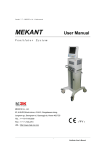
![User`s Manual MV2000[SU:M] Ventilator System 0470](http://vs1.manualzilla.com/store/data/005841388_1-c867b5a0773523e6306e353a41d4c56d-150x150.png)
